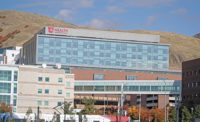The ongoing shift to bring health care services to the masses wherever they live has helped to ignite demand for new construction of ambulatory care centers nationwide. Even old, established institutions including the University of Pennsylvania Health System (UPHS)—which includes the 263-year-old Pennsylvania Hospital—are heavily investing in outpatient satellite centers.
The trend, one of several affecting the hospital and health care sector, calls for project teams that can remain as flexible with demand, schedules and costs as their clients, said speakers at ENR New York’s The Future of Healthcare Construction conference, held Feb. 26, in New York.
While institutions remain committed to modernizing their aging in-patient care facilities, the investment scales are more heavily tipped toward facilities in which patients can be treated and released without an overnight stay, speakers said.
"The future is in ambulatory care," says Gary Acord, executive director of planning, design and construction at Memorial Sloan Kettering Cancer Center (MSKCC), which forecasts annual capital spending at $100 million to $150 million, or about 60 projects a year. "We don’t predict a lot of growth in in-patient facilities" or in pure research facilities.
MSKCC’s current projects include the repurposing of a 286,000-sq-ft office building in Northern New Jersey to create a clinic as well as three buildings near its main campus on Manhattan’s Upper East Side. These include the $339-million, 179,000-sq-ft Josie Robertson Ambulatory Surgery Center on York Avenue, which is set for completion next year. On MSKCC’s Laboratory Medicine Building on East 64th St., Hunter Roberts Construction is the GC and Perkins + Will the architect. Completion of the 90,000-sq-ft building is expected in 2017.
The institution has also teamed up with The City University of New York/Hunter College to jointly develop a 760,000-sq-ft ambulatory care center at 74th Street. Despite community pushback, the project is moving along and is scheduled for completion in 2018. For both buildings, Perkins Eastman is the designer and Turner Construction is the contractor.
UPHS also has a massive capital program under way across several campuses. This includes its South Pavilion expansion project at the Perelman Center for Advanced Medicine. The project consolidates all of Penn Medicine’s outpatient programs under one roof and frees up space for more inpatient capacity elsewhere, says Kevin Mahoney, UPHS executive director.
UPHS’s "strategy in construction" includes flexibility in programs, phasing and technology, he says. It also includes integrating ambulatory care, education and research into one complex, he adds.
Meanwhile, speakers noted ongoing issues around project costs, setting budgets and when to set budgets.
"Tell us the bad news at the beginning. … Don’t tell us at the end that we need new risers or whatever to support the design," says Marsha Powell, engineering services director at the NYC Health and Hospitals Corp. "Our mandate from our board now is to know what projects cost."
"We are encouraging flexibility," especially with health care spread across regions and in smaller facilities, says Charles Abel, director of the Health Facilities Planning Division of the NYS Dept. of Health. "While consolidation [in the long-term care market] is occurring, the changes in the marketplace and the services delivered will change," he says. "What was envisioned as a viable model four or five years ago, is not [viable] now."
Speakers also said that building information modeling (BIM) software’s capabilities beyond construction—in, for example, forecasting future maintenance and managing the lifecycle of a building more efficiently—must be better communicated to clients.
"Even though the architect, engineer and contractor have done a lot of BIM, [using the technology] is still in the early stages” and more can be done, says Regis Gaughan, AKF Group’s Healthcare and Life Sciences director.
"I think the big story that we’re missing is the tie to return on investment (ROI)," Abel says. When clients clearly understand that "using the tool actually has an ROI to that building and the lifecycle of that building," the technology will be more quickly accepted and used.


Post a comment to this article
Report Abusive Comment